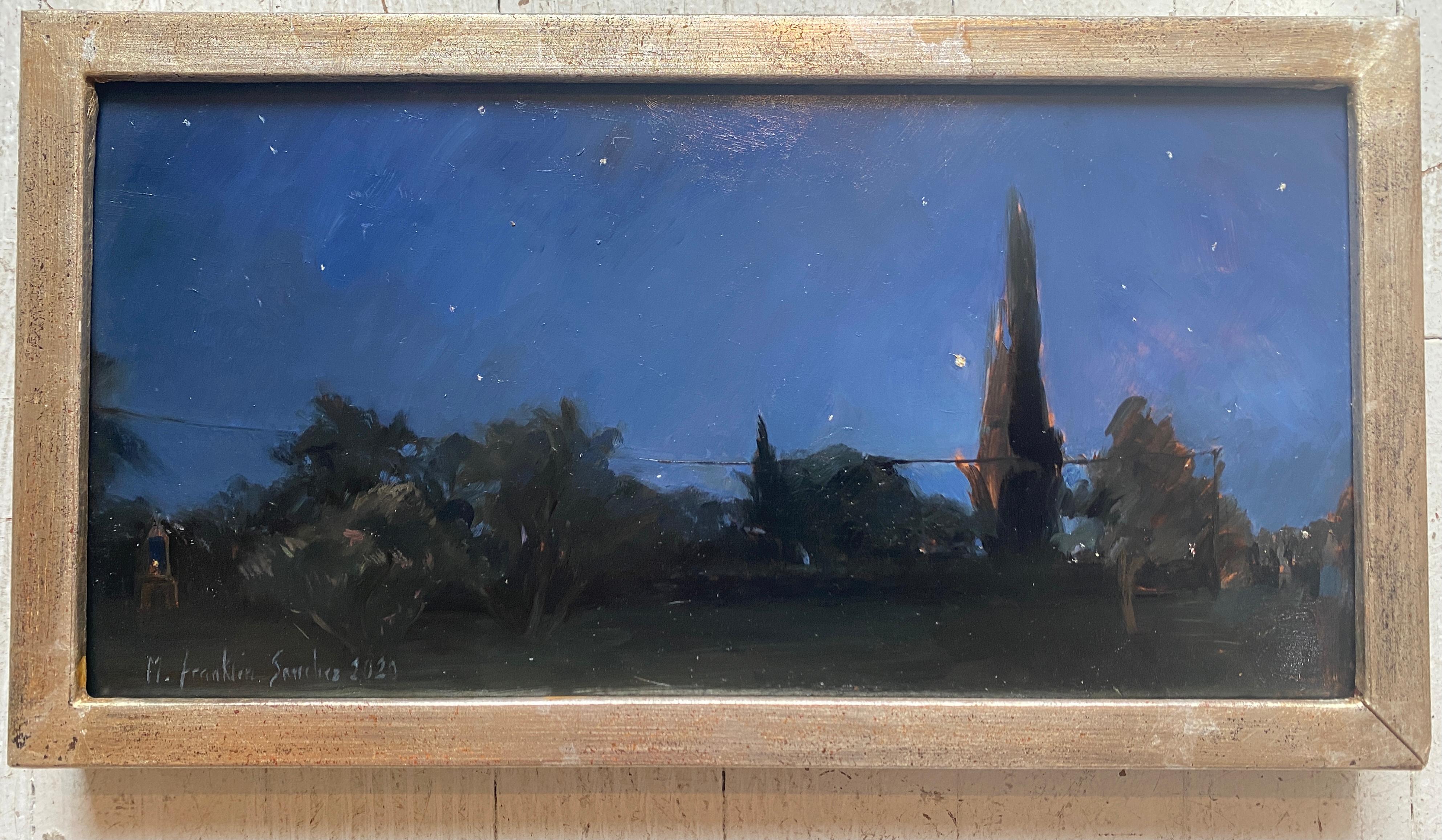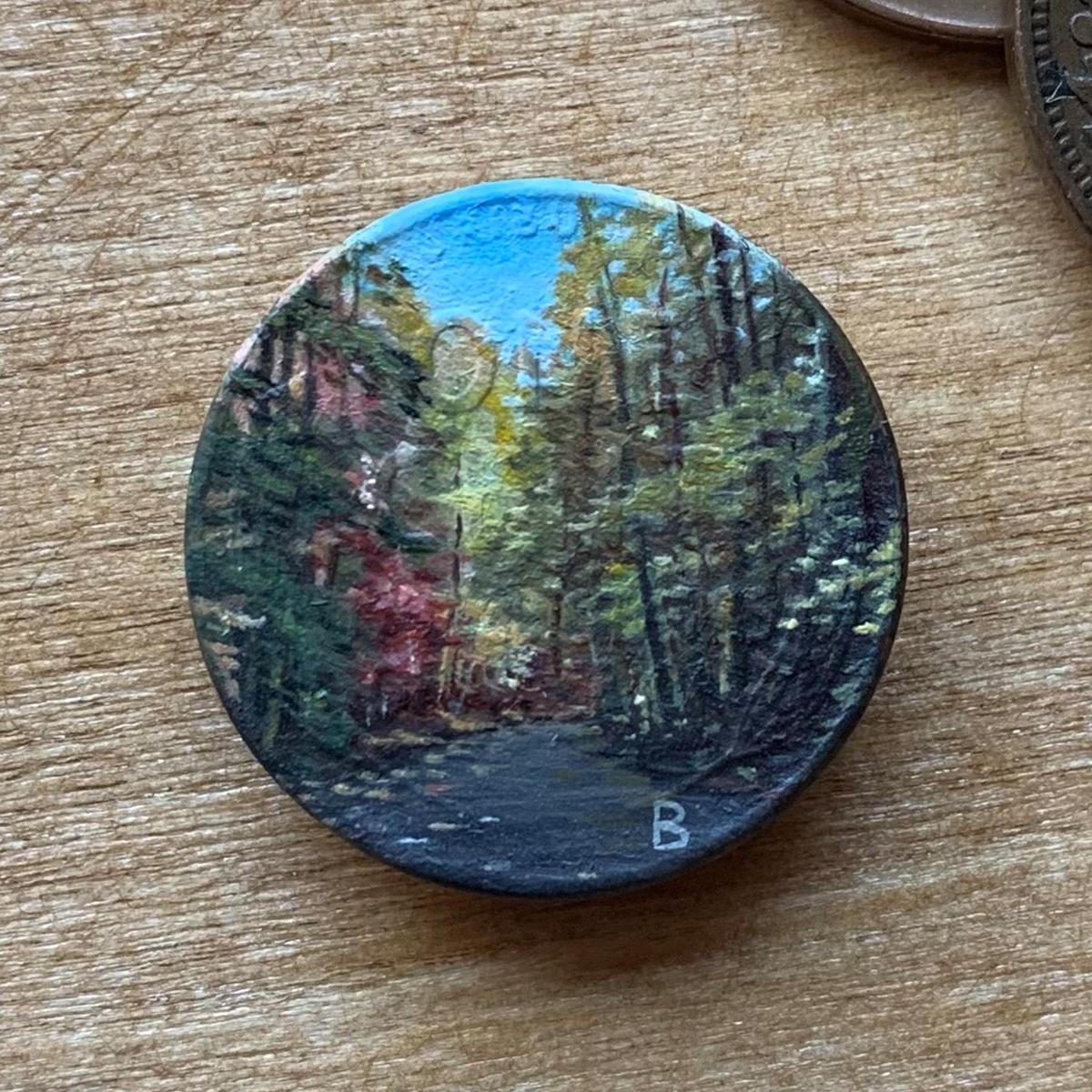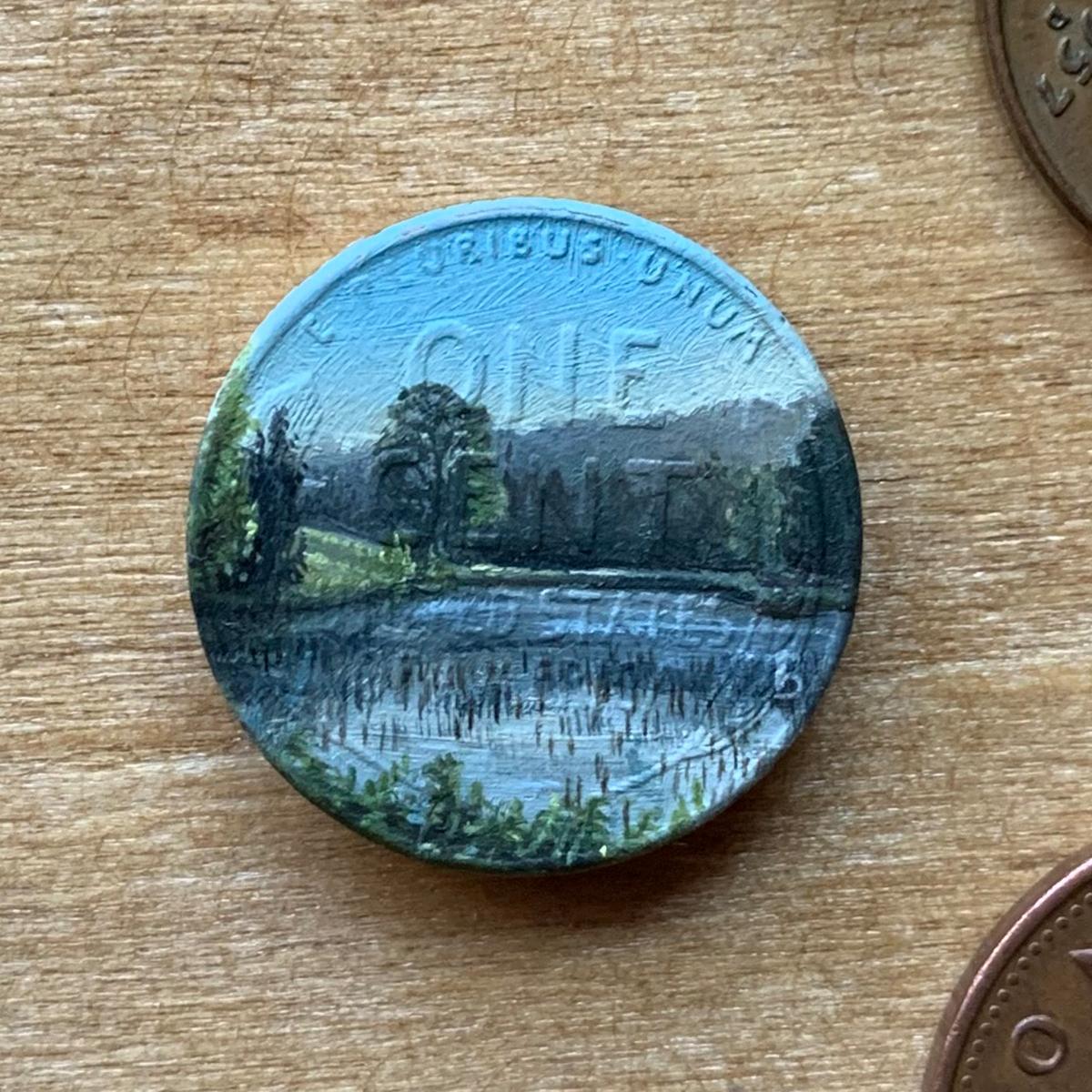Items Similar to Landscape with Ruins by the Tivoli Falls
Want more images or videos?
Request additional images or videos from the seller
1 of 6
Flemish School, 17th CenturyLandscape with Ruins by the Tivoli Falls
About the Item
Oil on copper
Image size: 15 x 10 1/2 inches (38 x 26.5 cm)
Period style hand made frame
This landscape depicts the area surrounding the Tivoli waterfalls in Italy. Thanks to its proximity in Rome, which lies some 30 km to the Southwest, Tivoli has long been a destination for artists. The Italian landscapists whose work was so coveted by Grand Tourist collectors—Claude, Gaspard Dughet and Salvator Rosa—all sketched there, while the Northern Italianates, including Cornelis van Poelenburgh, Pieter van Laer, and Gaspar van Wittel also sought out the spectacular views. Jan Brueghel the Elder drew the Temple of Vesta as early as 1593, using the drawing as a basis for a capriccio landscape. Tivoli boasts an ideal combination of factors: Classical ruins, rustic modern buildings, grottoes, a plunging cascade, Salvatorean wildness and of course significant historical and mythological associations.
In the eighteenth century, Tivoli and its temple gradually became one of the most represented subjects in the history of painting, particularly in French painting. The architectural perfection of its monuments, its location in the heart of a sublime and terrifying landscape, the incomparable richness of its history and legends, made it a subject revered by artists and collectors. It was also at this time that the temple of Tivoli was surrounded by workshops built in the gardens.
In this painting, at the top of the mountain on the left, we can see the Temple of vesta - a small circular Roman temple in Tivoli, Italy, dating to the early 1st Century BC. Its ruins are dramatically sited on the acropolis of the Etruscan and Roman city, overlooking the falls of the Aniene and a picturesque narrow gully. As depicted here, the temple's capitals have much been admired and imitated, and their variation of the Corinthian order sometimes even called the 'Tivoli order'. The Temple of Vesta itself sits within the larger complex of the Villa Gregoriana overlooking the falls of the Aniene river. The Temple’s iconic and immediately recognisable silhouette made it a sort of shorthand for ‘Italy’, and thus it appeared in landscape paintings of all sorts, both naturalistic and imaginary. Copies of the building itself were requested for eighteenth century English gardens including those at Stowe, Stourhead, and Downhill, where they signified the taste and culture of the estate owners.
- Creator:Flemish School, 17th Century (1600 - 1699)
- Dimensions:Height: 10 in (25.4 cm)Width: 15 in (38.1 cm)
- More Editions & Sizes:1 of 1Price: $6,618
- Medium:
- Period:Early 17th Century
- Condition:
- Gallery Location:London, GB
- Reference Number:1stDibs: LU52413901892
About the Seller
5.0
Vetted Seller
These experienced sellers undergo a comprehensive evaluation by our team of in-house experts.
Established in 2007
1stDibs seller since 2014
64 sales on 1stDibs
Typical response time: 4 hours
- ShippingRetrieving quote...Ships From: London, United Kingdom
- Return PolicyA return for this item may be initiated within 14 days of delivery.
More From This SellerView All
- Turkish Scene, 19th Century British School VictorianLocated in London, GBBritish School 19th Century Turkish Scene Oil on board Image size: 13 ½ x 10 ½ inchesCategory
19th Century Victorian Landscape Paintings
MaterialsBoard, Oil
- View from a Bedroom Window, 20th Century English School, Oil LandscapeLocated in London, GBOil on board Image size: 12 x 15 inches (30.5 x 38 cm) Contemporary style frameCategory
20th Century Modern Landscape Paintings
MaterialsOil, Board
- Around the Camp Fire, 19th Century Oil Landscape Painting, Dated 1840Located in London, GBOil on canvas, signed bottom right and dated '1840' Image size: 22 x 30 inches (56 x 76.25 cm) Albert Bierstadt Recognized as the foremost painter of the American frontier during the nineteenth-century, Albert Bierstadt was born in Solingen, Germany, in 1830. At the age of two, he and his family emigrated to the United States, settling in New Bedford, Massachusetts. Nothing is known of his early art training; however, he might possibly have been influenced by local landscape painters. By the time he was twenty, he was supporting himself by teaching "monochromatic" painting and his work was beginning to attract the attention of New Bedford collectors. In 1853, Bierstadt traveled to Düsseldorf in order to broaden his art education. It was there that he was associated with such American artists as Worthington Whittredge and Carl Wimar, all of whom frequently gathered in the studio of the German-American history painter, Emanuel Leutze...Category
1840s Landscape Paintings
MaterialsCanvas, Oil
- Port of Fowey, Cornwall, Oil Painting on Canvas, English SchoolLocated in London, GBOil on canvas on board, signed on reverse Image size: 19 3/4 x 15 1/4 inches (50 x 39 cm) Original frame This charming scene depicts the harbour of Fowey, a small town in South Cornwall. The port town...Category
20th Century English School Landscape Paintings
MaterialsCanvas, Oil
- The Standing Stone Wall, 20th Century English Signed, Oil LandscapeLocated in London, GBOil on canvas, signed and dated '1948' bottom right Image size: 10 3/4 x 16 1/2 inches (27.25 x 42 cm) Contemporary style hand made frame The Artist Hugh Griffiths was a painter who was born in Karachi. Was educated at Canford School and the Dragon School, Oxford. Showed at RA, RBA and NEAC. Griffiths lived at Winchelsea and later St Leonards...Category
Mid-20th Century Modern Landscape Paintings
MaterialsCanvas, Oil
- Landscape with Rocky VistaLocated in London, GBOil on oak panel Image size: 6 1/4 x 6 1/4 inches (15.75 x 15.75 cm) Period ebonised frame Patinir’s poetic imagination allowed him to express an idealised world, or one steeped in pathos, with profound sentiments, and always with perfect technique. The level of detail in this work is astonishing and the viewer is sure to make new discoveries every time that they gaze upon it, such as the birds diving down from the rocky form or the spindly poles that hold up the bowing bridge. Patinir's landscapes recall the background landscapes in the work of his contemporary Netherlandish painters, such as Gerard David. His magnificent rendering of light and shadows also foreshadow the great Dutch masters of the 17th century; as well does his excellent use of colour—especially his delightful range of blues and greens. Together, these traits make his works both innovative and uncommonly attractive. Here, although the scene is populated, the figures are small and the landscape assumes increasing importance. Joachim Patinir Joachim Patinir, who was born on the banks of the Meuse River, is considered the first Flemish landscape painter. His vast, highly personal landscapes are characterized by large expanses of terrain with high horizons and fantastic outcroppings of pointed rock that combine real and symbolic. He is thought to have begun his career in Bruges, where he discovered the work of Gérard David, but like David, he appears on a list of Antwerp-based masters in 1515. There, he met and befriended Albrecht Dürer, who visited the Netherlands in 1520-1521. Dürer subsequently painted his portrait and even attended his daughter’s wedding. Patinir was also friends with Quintin Massys, who painted some of the figures in his works. Their friendship was so lasting that Massys’ son, Cornelis, apprenticed with Patinir. Cornelis eventually married Patinir’s daughter, Francisca Buyts, and the elder painter became their tutor. In 1521, Patinir remarried, this time to Jeanne Nuyts. His life was quite short, and he produced relatively few paintings, notwithstanding certain mediocre works erroneously attributed to him. His fame is due primarily to his final paintings, whose masterful technique and creativity were praised by his peers. In his travelogue, Dürer called him "a good landscape painter", and Felipe de Guevara, a friend and artistic assessor to both Charles V and Philip II, mentions him in his "Commentaries on Painting" (1540) as one of the three greatest painters, alongside Rogier van der Weyden and Jan van Eyck. His work was also very successful on the art market, especially when we recall that, in 16th-century Antwerp, artists did not work on commission. Instead, they sold finished works to their clients. From the very start, Patinir’s paintings reflect the influence of Hieronymus Bosch, although they lack that master’s satirical edge. He was also influenced by Gérard David, from whom he drew his perfect execution as well as his taste for landscape. His name appears on two early works—"Saint Jerome" (Staatliche Kunsthalle, Karlsruhe) and "The Flight to Egypt" (Koninklijk Museum voor Schone Kunsten, Antwerp)—but his inscriptions on three other panels—"The Baptism of Christ" (Kunsthistorisches Museum, Vienna), "Landscape with...Category
16th Century Flemish School Landscape Paintings
MaterialsOak, Oil
You May Also Like
- Summer NightsBy Melissa Franklin SanchezLocated in Sag Harbor, NYSummer Nights is a small painting, oil on copper, depicting a dark blue sky over a green landscape, in Fiesole, Italy. Melissa Franklin Sanchez softly merges warm tones with cool ton...Category
21st Century and Contemporary Realist Landscape Paintings
MaterialsCopper
- As Uncommon As 3152By Kate SalenfriendLocated in Napa, CASurrounded by artistic inspiration from a very early age, Kate Salenfriend learned most of her technical skills from her great-grandfather, Stewart Robertson, the registered Californ...Category
2010s Contemporary Landscape Paintings
MaterialsCopper
- "Incoming Weather 1949" Mixed Media PaintingLocated in Denver, COBryanna Marie's "Incoming Weather 1949" is an original, handmade oil painting on a copper coin that depicts a white house with storm clouds swelling in the background. About the Ar...Category
2010s Contemporary Figurative Paintings
MaterialsCopper
- "Autumn Up North 1951D" Mixed Media PaintingLocated in Denver, COBryanna Marie's "Autumn Up North 1951D" is an original, handmade oil painting on a copper coin that depicts a path bordered by fall colored foliage and t...Category
2010s Contemporary Figurative Paintings
MaterialsCopper
- "Still Reflections 1958D" Mixed Media PaintingLocated in Denver, COBryanna Marie's "Still Reflections 1958D" is an original, handmade oil painting on a copper coin that depicts a body of water reflecting all the greenery...Category
2010s Contemporary Figurative Paintings
MaterialsCopper
- "The Young Maple 1940" Mixed Media PaintingLocated in Denver, COBryanna Marie's "The Young Maple 1940" is an original, handmade oil painting on a copper coin that depicts a blue and yellow sky arching behind a leafy maple tree. About the Artist...Category
2010s Contemporary Figurative Paintings
MaterialsCopper
Recently Viewed
View AllMore Ways To Browse
1st Century
Classical Ruins
Roman Ruins
Flemish Style
Eighteenth Century Art
Roman Ruins Art
Italian 17th Century Frame
17th Century Italian Painting
Roman Ruins Drawings
Antique English 17th Century
Flemish Landscape Painting
17th Century Oil Landscapes
Antique Flemish Frame
17th Century Italian Oil
17th Century Italy Oil
Eighteenth Century French
Long Narrow Art
Antique Sorter





